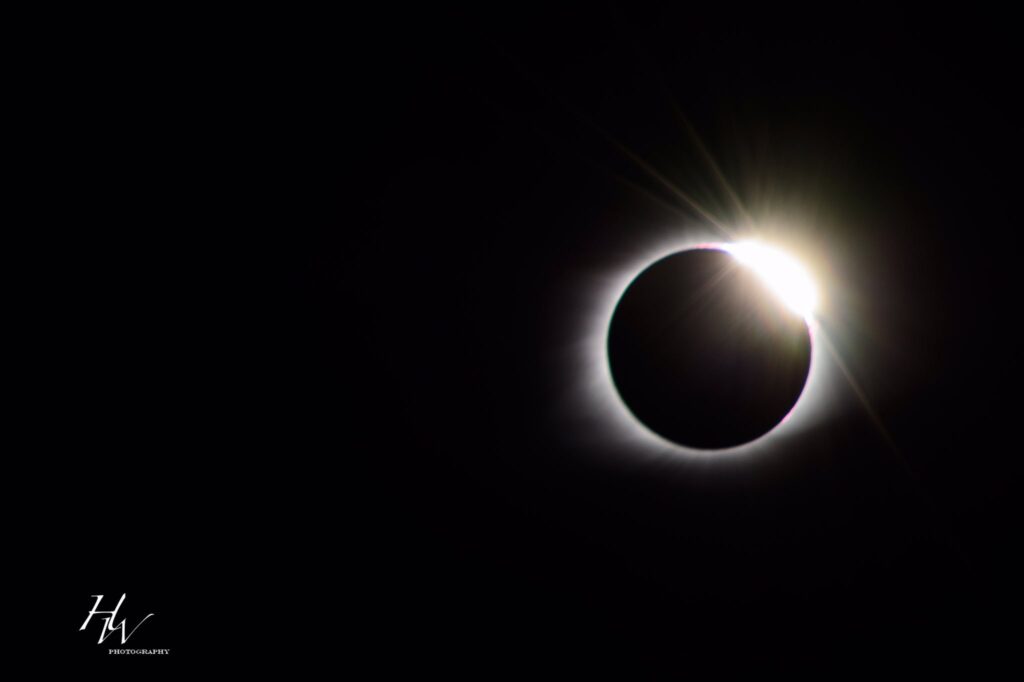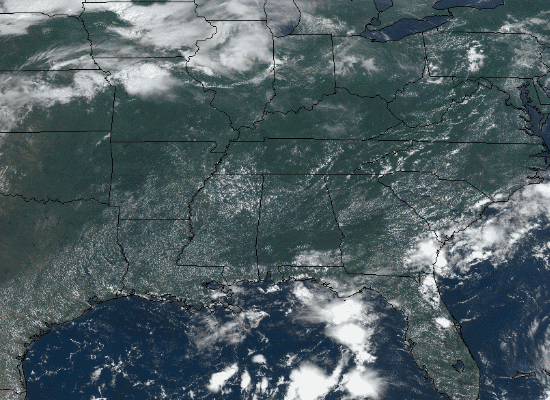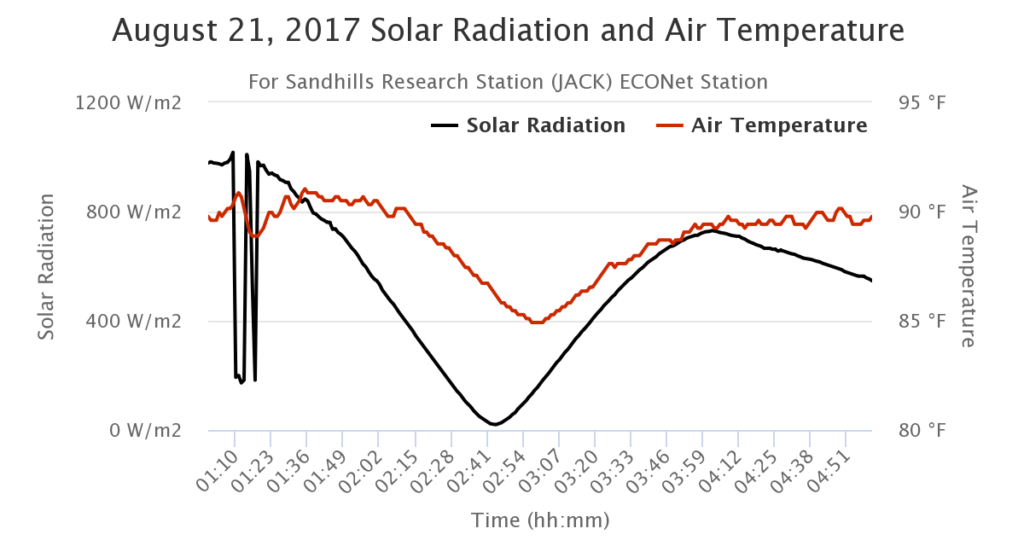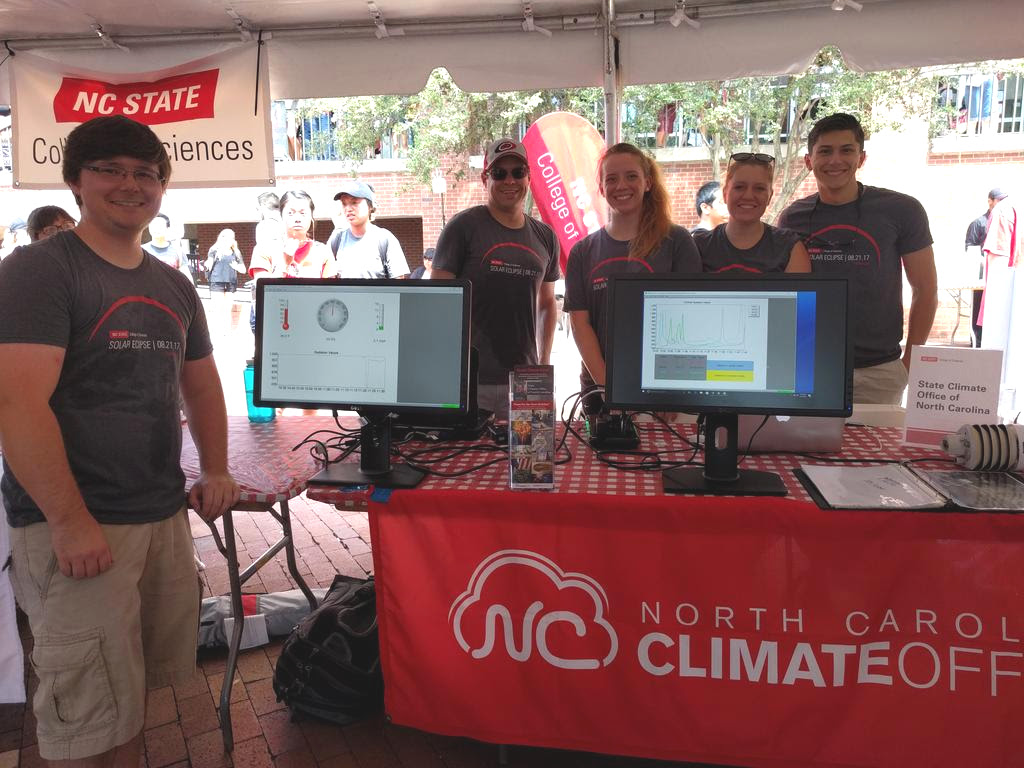Along with providing a rare sight in the skies, last week’s solar eclipse had a distinct impact on weather conditions in North Carolina.
Our 40 ECONet stations measure ambient conditions every minute, and after reviewing their data and crunching the numbers, we’ve seen how the eclipse affected solar radiation and air temperatures across the state.
Here’s an overview of some of the more interesting observations and statistics from our network.

Receding Radiation
Our seven westernmost stations in the Mountains, including the two in the path of totality on Wine Spring Mountain and Sassafras Mountain, all saw their solar radiation values hit zero at some point between 2:30 and 2:45 pm last Monday.
While they didn’t drop all the way to zero, the rest of our stations recorded a noticeable drop in solar radiation that afternoon.
For the sake of comparison, the average solar radiation at 3 pm the day before the eclipse was 743 Watts per square meter. On the afternoon of the eclipse, the average minimum solar radiation from our network was 21 Watts per square meter — a decrease of 97 percent from the previous day!

Even at our northeasternmost site at Buckland Elementary School in Gates County, the solar radiation still dropped to 72 Watts per square meter at 2:47 pm, when the eclipse reached its maximum 88% coverage at that location.
Although much of the state did see some cloud cover on the morning of the eclipse — and parts of the Mountains and the Triad were plagued by clouds through the afternoon — we did get some nice camel hump-like radiation curves from some of our stations.
At our Sandhills Research Station in Jackson Springs, for instance, you can see a few dips in the solar radiation as clouds moved through, but once the partial eclipse began around 1:15 pm, the radiation began to steadily drop until bottoming out at 20 Watts per square meter at 2:44 pm. After that, radiation values began rising again until they reached their normal afternoon levels once the partial eclipse ended just after 4 pm.

Tumbling Temperatures
If you were outside during the eclipse, you may have noticed its effects as the temperatures fell. Our Burnsville station in the Mountains dropped 8.3 degrees — from 82.4°F to 74.1°F — from 2 pm to 3 pm!
| Station | Temperature Decrease | Notes |
|---|---|---|
| Burnsville | 8.3°F | (greatest observed decrease) |
| Spruce Pine | 7.7°F | |
| Sassafras Mtn., SC | 5.9°F | (within the path of totality) |
| Wine Spring Mtn. | 5.8°F | (within the path of totality) |
| Mount Mitchell | 5.0°F | |
| NCSU Brickyard | 4.2°F | (from our mini weather tower) |
| Bearwallow Mtn. | 1.8°F | (smallest decrease; due to cloud cover) |
Across the network, we observed an average temperature decrease of 5.2°F during the 90-minute period from 2:00 to 3:30 pm. However, there is something interesting about how the temperatures responded during the eclipse.
Unlike the solar radiation, which decreased as soon as the partial eclipse began and bottomed out when coverage hit the peak, the temperatures had a bit of a delay. At Jackson Springs, for instance, the lowest temperature — 84.9°F, after a 6.1 degree drop — didn’t occur until 13 minutes after the minimum solar radiation.
That temperature lag occurs because the air is slow to respond to solar heating, or the lack thereof. As the sun heats the ground during the day, the heat exchange into the air doesn’t happen immediately. Likewise, once solar radiation decreases, it takes time for the air — especially water vapor molecules in it — to dissipate their heat.
So if you went back inside as soon as the peak of the eclipse was over, you might have seen the best part of the show in the sky, but you probably didn’t feel its full effects in the air.
Eclipse on Campus
Many of our office’s staff and students took in the eclipse from the NC State College of Science’s Eclipse Day Celebration event.
While the skies dimmed and the temperatures fell around us, we monitored conditions from across the state and from our mini weather tower on the Brickyard.

Activities at the event ranged from the creative — such as making pinhole projectors to safely view the eclipse — to the close-up — like viewing the eclipse through a telescope equipped with a solar filter from the astrophysics department.
Attendees also saw some science in action as the NC State Soundings Club launched a weather balloon equipped with instrumentation to collect data from the upper atmosphere.
Overall, the Eclipse Day Celebration was a great chance for our office to connect with the campus and the broader community, all while witnessing some stunning scenes in the sky.